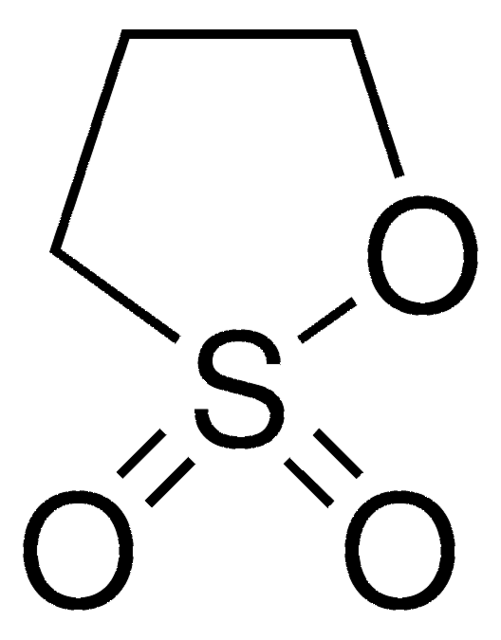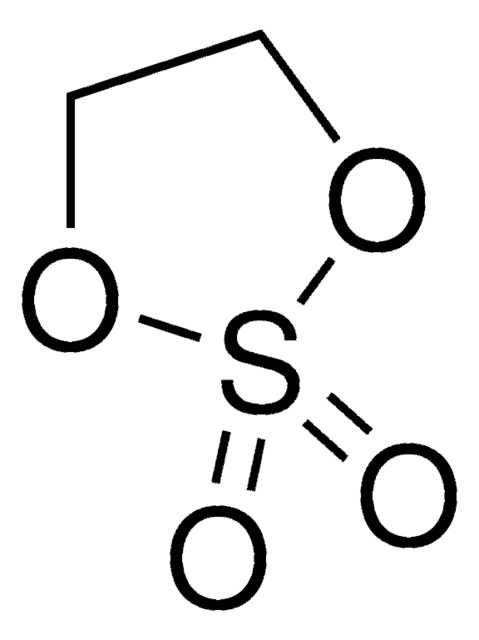Wichtige Dokumente
901588
1,3-Propanesultone solution
1 M in THF
Synonym(e):
1,2-Oxathiolane 2,2-dioxide, 3-Hydroxypropanesulfonic acid γ-sultone
About This Item
Empfohlene Produkte
Form
liquid
Konzentration
1 M in THF
Brechungsindex
n/D 1.4144
Dichte
0.9266 g/mL
InChI
1S/C3H6O3S/c4-7(5)3-1-2-6-7/h1-3H2
InChIKey
FSSPGSAQUIYDCN-UHFFFAOYSA-N
Anwendung
- preparation of poly[2-ethynyl-N-(propylsulfonate)pyridinium betaine], a new ionic conjugated polymer[1]
- preparation of novel poly(4-vinylpyridine) supported acidic ionic liquid catalyst[2]
- preparation of poly((2-(dimethylamino)ethyl methacrylate)-co-3-dimethyl(methacryloyloxyethyl)ammonium propanesulfonate)-coated mesoporous silica nanoparticles[3]
- sulfonation of surface of self-assembled nanoporous silica colloidal crystalline films comprised of 184nm-diameter silica spheres[4]
Ähnliches Produkt
Signalwort
Danger
Gefahreneinstufungen
Acute Tox. 4 Oral - Carc. 1B - Eye Dam. 1 - Flam. Liq. 2 - Skin Irrit. 2 - STOT SE 3
Zielorgane
Central nervous system, Respiratory system
Zusätzliche Gefahrenhinweise
Lagerklassenschlüssel
3 - Flammable liquids
WGK
WGK 3
Flammpunkt (°F)
-2.0 °F
Flammpunkt (°C)
-18.88 °C
Zulassungslistungen
Zulassungslistungen werden hauptsächlich für chemische Produkte erstellt. Für nicht-chemische Produkte können hier nur begrenzte Angaben gemacht werden. Kein Eintrag bedeutet, dass keine der Komponenten gelistet ist. Es liegt in der Verantwortung des Benutzers, die sichere und legale Verwendung des Produkts zu gewährleisten.
EU REACH SVHC Candidate List
EU REACH Annex XVII (Restriction List)
Hier finden Sie alle aktuellen Versionen:
Analysenzertifikate (COA)
Die passende Version wird nicht angezeigt?
Wenn Sie eine bestimmte Version benötigen, können Sie anhand der Lot- oder Chargennummer nach einem spezifischen Zertifikat suchen.
Besitzen Sie dieses Produkt bereits?
In der Dokumentenbibliothek finden Sie die Dokumentation zu den Produkten, die Sie kürzlich erworben haben.
Active Filters
Unser Team von Wissenschaftlern verfügt über Erfahrung in allen Forschungsbereichen einschließlich Life Science, Materialwissenschaften, chemischer Synthese, Chromatographie, Analytik und vielen mehr..
Setzen Sie sich mit dem technischen Dienst in Verbindung.










